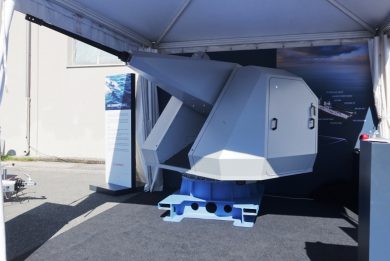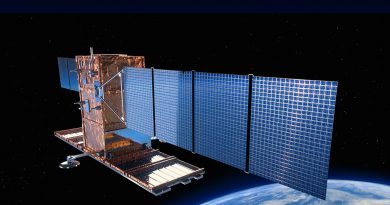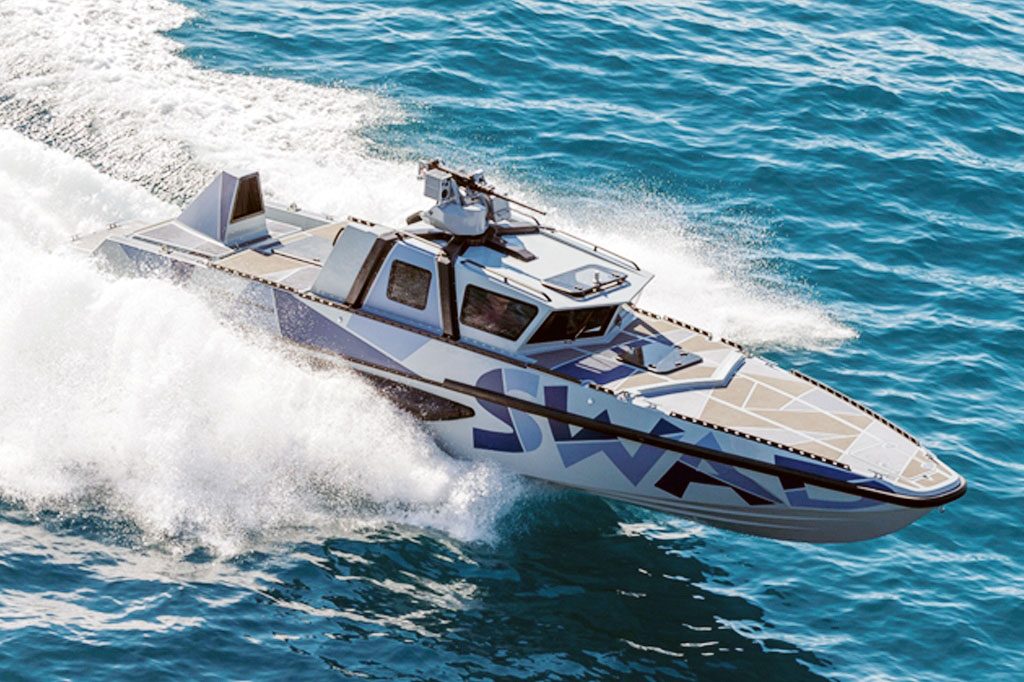
Leonardo unveils its Lionfish naval remotely controlled weapon stations
With an increased shift of naval operations from blue to littoral waters, and the corresponding growth of the types of threats faced by large and small naval units, Leonardo decided to leverage its experience in the small calibre gun systems field acquired with its Hitrole family to propose a new range of solutions to its customers.
Known as Lionfish, the new family of Naval Remotely-controlled Weapon Station (NRWS) is aimed first at light units, such as Offshore Patrol Vessels (OPVs) and smaller, which would adopt them as main armament, but can also be considered for providing larger ships with improved inner layer defence capabilities.
Although some of the Lionfish have a great resemblance to the former Hitrole, the new mounts leverage the technology and experience acquired by Leonardo on the 76/62 SR and 127/64 LW gun systems. New Italian-made servo-systems were installed, all Lionfish NRWS being fully stabilised in elevation and azimuth thanks to two independent gyros, two tachometers ensuring backup stabilisation, servo-systems operating in closed loop with the stabilisation system. All elements that were installed under the rotation plane were relocated, the Lionfish being thus a true over-deck non-penetrating system.
A major improvement was made in the optronic suite; two options are proposed, both from Leonardo, the Mini-Colibri, which features a 640×480 uncooled LWIR (8-12 µm) thermal imager and a daylight full-HD CMOS sensor, together with a 5.5 km range laser rangefinder. According to Leonardo, the detection, recognition and identification ranges (D/R/I) at night are respectively 6.3, 3.0 and 1.5 km, while the day sensor provides ranges of 9.5, 4.8 and 2.7 km, against a 2.3×2.3 meters NATO target. Another plus compared to previous Hitrol turrets is that now a single alignment operation is required for all three optronic systems, day, thermal and LRF. To fully exploit the performances of the new optronic sites Leonardo engineers optimised tracking algorithms, improving target data accuracy even when dealing with coastal type operational scenarios, where the target can easily merge with the background.
Three of the four Lionfish family NRWS are armed with a 12.7×99 mm machine gun, usually the FN M2HB QCB manufactured by FN Herstal of Belgium, while one is armed with a 20 mm cannon, the KAE gun from Rheinmetall Defence firing the 20×128 mm ammunition.
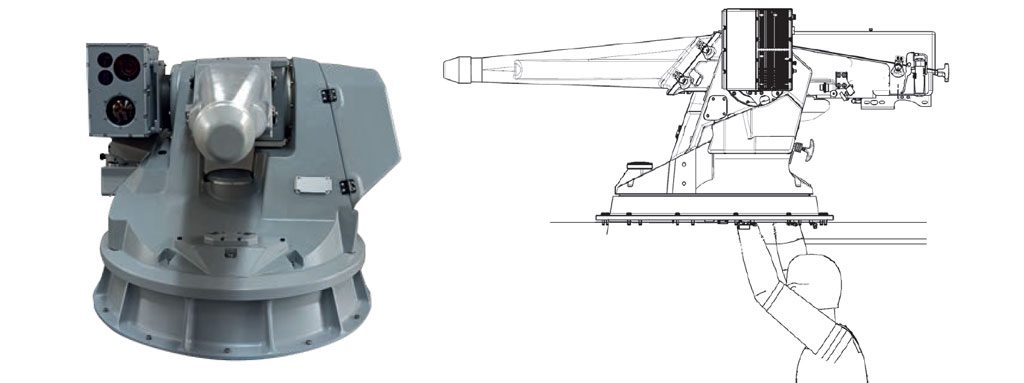
The Lionfish Inner Reloading has a very close resemblance to the former Hitrole N (for Naval); the latter key characteristic was that it allowed the crew to reload the ammunition from under deck, a feature also available on the land version. An opening under the turret allows the operator to link the new ammunition belt to the one nearly empty, an utmost important feature when the Lionfish turret is located on the bow and the vessel operates in heavy sea state or under enemy fire. In case of need the operator can override the system that stops the ammunition belt when only few rounds are left, allowing to shoot until the last round, however it is then necessary to reload above deck. The Inner Reloading has 100 rounds ready to fire, but as said the crew can easily add further belts from inside the boat. As all Lionfish remotely controlled turrets this version has a ±155° training range, while its elevation is -15°/+50°; the training speed is 60°/s while acceleration is 150°/s2. The whole turret weighs less than 270 kg, its deck interface diameter being 820 mm, while its dimensions are 1,828 x 962 x 800 mm.
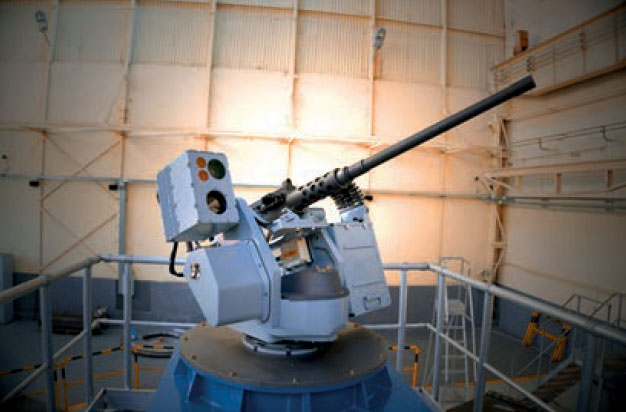
The Lionfish Ultralight look is similar that of the land Hitrole Light, but turret mechanics are completely new, the design allowing a considerable reduction in the number of components as well as in mass, the new NRWS weighing less than 190 kg; it features the improved rearming mechanism common to all the family turrets, as well as the common electronic architecture. The ammunition reload is done over the deck, the case on the left side hosting up to 250 12.7 mm rounds. As no through deck feed is needed, its interface diameter is much smaller, only 320 mm. While all other data remain similar, the one that varies considerably is the elevation range, which here is of -20°/+70°. The firing rate depends on the machine gun installed, and ranges between 485 and 635 rounds per minute, the same for all the other 12.7 mm turrets.
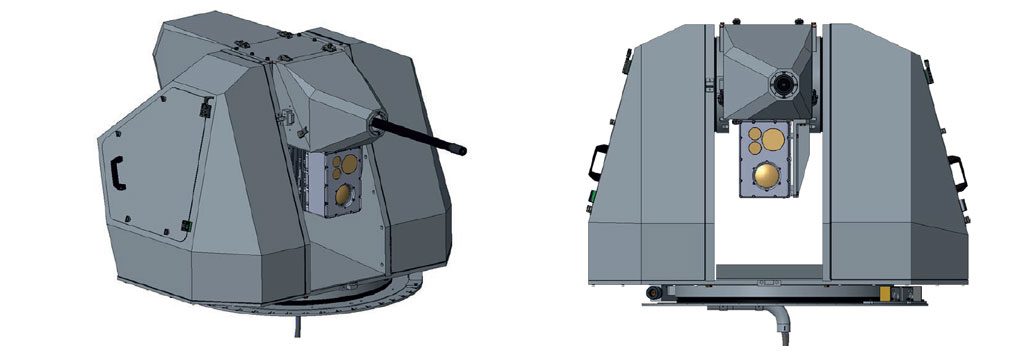
The top-tier member of the 12.7 mm Lionfish family is named Top; its architecture is however quite different, and can be partly traced back to that of the Hitrole 20 mm, which was however a much heavier turret. Here differences between the Lionfish and the Hitrole are much greater. The structure is nearly symmetric, as the sensor package has been moved under the gun; instead of the Mini Colibri here the system installed is the newly developed Mini-Colibri Cooled, where the LWIR microbolometer is replaced by a cooled MWIR (3-5 µm) sensor, providing longer range DRI performances, respectively 12, 6 and 3.3 km. The ammunition box on the left contains up to 400 rounds, 12.7 mm rounds being effective up to 1,500 meters. A key feature for close in defence is the negative elevation range, which goes to -30°, while positive elevation is increased up to 75°. The weight is obviously the higher among the three Lionfish 12.7 mm turrets, although it is less than 325 kg.

The Lionfish 20 is the biggest member of the Lionfish family, however its structure remains that of the Lionfish Top. The same applies to the actuators, therefore acceleration is reduced to 115°/s2 due to the heavier weight of the weapon while angular speed is nearly unaffected. The elevation range does not vary on the negative side, while positive elevation decreases only slightly, to 70°. The ammunition case contains up to 250 rounds, controlled fire rate ranging from 100 to 300 rounds per minute, while burst mode raises it at 1,000 rpm. Effective range is increased to 2,000 meters, but what makes an even bigger difference is the fact that 20×128 mm rounds are not ball rounds but contain high explosive, thus delivering a wholly different level of lethality on the target, for a turret weight of only 450 kg.
As anticipated, all four Lionfish turrets feature the same electronic architecture. The turret is linked to the Logic Control & Move Unit (LCMU), the core of the system that ensures ballistic computation and target trajectory estimation, and which also hosts the “ID card” of the turret, which contains all installation data such as i.e. obstacle control zones and no-fire zones, allowing to remove the turret and reinstall it without the need of further operations, as all data can be retrieved from the card. The LCMU can be linked to the combat management system, in that case firing data would be provided by the ship system, and/or to the wholly new user-friendly Local Control Console. Compared to the old 800×600 resolution 12-inch screen the new LCC features a 1280×1024 resolution 17-inch touch-screen as well as two ergonomic multifunction joysticks which allow to access a greater number of functionalities. While selectors in the lower part of the console ensure the control of key functions such as on/off, fire safety, motion safety, emergency (combining fire and motion safety), night mode and local/remote, a number of commands available through joysticks are replicated on a graphic interface thanks to the availability of the touch screen. The LCMU and the turret are linked to the Power Supply unit, which also hosts a battery that ensures 30 minutes of operation should the ship power system fail. A scenario simulator can also be linked, providing air and surface targets for training purposes.

Leonardo also updated its Marlin range of medium calibre remotely controlled turrets. The Marlin 30 takes over from the Marlin-WS, and is proposed only with the Northrop Grumman ATK Mk44 30×173 mm dual-feed cannon. The training range stepped up from ±140° to ±155° thanks to some upgrades in servo-systems, while elevation remained -19°/+70°. It is proposed in three configuration, RC (Remotely Controlled) fully integrated into the ship CMS/FCS from which it receives target data, COAX fitted with an electro-optical sensor suite and on-board computer providing ballistic computation and target prediction, and ILOS (Independent Line Of Sight), with a panoramic sight featuring state-of-the-art day and night sensors allowing improved search and detection capabilities, mostly adopted for stand-alone installation. Weight varies between 1,200 and 1,430 kg, depending on configuration, to which we must add the mass of the 160 ready-to-fire 30×173 mm rounds. The deck interface has a 1,050 mm diameter, the same of the Marlin 40 which shares with the smaller calibre turret, in ILOS configuration, also the optronic package based on a cooled thermal camera and a TV camera, with DRI ranges respectively of 15, 6.8 and 3.5 km and 20, 9 and 4.5 km, the laser rangefinder having a 6.5 km range, the 30 mm cannon maximum effective range being 3.5 km while that of the 40 mm is 1,000 meters higher.
The major improvement on the 40 mm is that the new mount is fitted with a slip ring that allows to turn freely on 360°, elevation remaining -20°/+85°. The turret weight without ammo is 2,100 kg, 80 ready to fire rounds being available to the Leonardo-produced 40L70 gun. With its new and updated small and medium calibre remotely controlled turrets Leonardo aims at increasing its footprint in the light patrol vessels segment and in that of secondary armament on bigger surface ships.
Photo courtesy Leonardo


